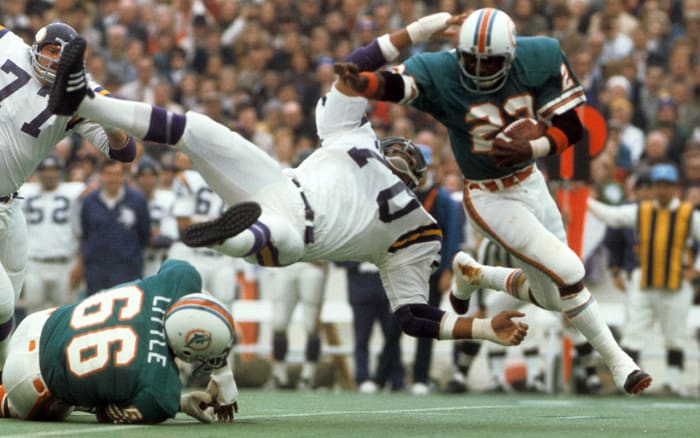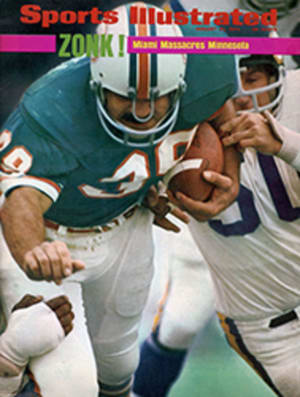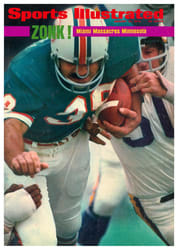It Was The Day Of The Dolphins
Super Bowl VIII had all the excitement and suspense of a master butcher quartering a steer. The slaughterhouse was Houston's Rice Stadium and the butcher was Miami Quarterback Bob Griese, whose deft dismemberment of the Minnesota Vikings may have had a certain esthetic appeal for serious students of the science of football, but left devotees of drama more than a little bored.
The suspense in the game, which Miami won 24-7, lasted for five minutes and 27 seconds, which was the time it took Griese to march his Dolphins 62 yards in 10 plays after the opening kickoff. Most of the drive was predicated on the ability of the Miami offensive line to shunt aside the Minnesota defenders, especially Middle Linebacker Jeff Siemon, who was attacked by a bewildering variety of blockers.
Griese wound up his opening salvo by turning a Minnesota ploy against the Vikings. With a first and goal on the Minnesota five-yard line, he forsook power for finesse. The two excellent Dolphin guards—Bob Kuechenberg and Larry Little—pulled and took off in tandem to their right. The Viking line, keying on the guards and reading sweep, went with them and Griese handed the ball to Larry Csonka (see cover), who ambled through the hole created by the absence of Minnesota's left tackle, Gary Larsen. It was a clever call and a cleanly performed play and it was archetypical of the way the Dolphins executed their appointed tasks—and their opponents—throughout the chill, foggy afternoon.
When the Vikings took over following the Miami touchdown, they ran three ineffectual plays, had to punt and the Dolphins sliced them up again, using 10 plays to go 56 yards at an expenditure of five minutes and 46 seconds. This time Jim Kiick thrust over from the one.
Griese threw two passes in each of the drives. The Miami game plan was not based on throwing the ball; it was founded primarily on clearing out the middle of the Minnesota defensive line and handing the ball to Csonka. Given a Csonka to lug the ball 33 times and rumble for 145 yards, it made a lot of sense.
Griese threw only seven passes, completing six, all but one of them in the first half. With the Dolphins holding a 17-0 halftime lead—Garo Yepremian kicked a 28-yard field goal, to boot—they didn't need to pass. But the one time Griese put the ball in the air in the second half doomed any chance the Vikings had of winning. This came early in the third period, on third and five from the Viking 38, when Minnesota seemed to be stiffening a bit. The pass went to Paul War-field as the Dolphins' All-Pro wide receiver fled down the left sideline, kicking past Bobby Bryant to make a diving fingertip catch. The play covered 27 yards, put Miami on the Viking 11 and set up the touchdown that took the game out of reach. Csonka—who else?—scored it by running over some Minnesota people from the two.
Although the Vikings were thoroughly outperformed by a team that on this day deserved to rank among the top two or three clubs ever to play the game, there are a few things to be said in mitigation of Minnesota's showing.
Before the game a panel of spiritualists and mediums had unanimously predicted the Vikings would win because all the planets in Coach Bud Grant's birth line were in a favorable position. The mediums certainly did not get the message. Each time Minnesota showed signs of making a game of it, the planets evidently careened out of alignment. Late in the first half, with a yard to go for a first down and six for a touchdown, Oscar Reed was stopped for no gain, fumbled and the Dolphins recovered. Viking John Gilliam returned the second-half kickoff 65 yards to the Miami 34, but a clipping penalty on Tight End Stu Voigt brought the ball all the way back to the Minnesota 11-yard line.
On the third-period drive that put Miami ahead by 24 points, the Vikings, on a third and four, surged through the Dolphin line, dropping Mercury Morris for an eight-yard loss and apparently setting up a field-goal attempt. But Minnesota was assessed with a rare defensive holding penalty, giving Miami a first down on the Minnesota eight. Csonka scored two plays later.
Then in the fourth period, when the Vikings for the first time generated a drive on Tarkenton's nifty passing and scored a touchdown on Tarkenton's nifty four-yard run to make it 24-7 with nearly 12 minutes to play, they ran into more bad planetary confluence. They recovered an onside kick that would have put them in position for another score but Reserve Linebacker Ron Porter was offside and Minnesota had to kick off again from its 35. This time the ball was run back to the Miami 34. The Vikings held, but Larry Seiple's long punt bounced straight up and died on the Viking three-yard line, where it was downed. At this lugubrious point a Minneapolis sportswriter threw his pencil on the floor and tore up his notebook.
After the game, Viking Coach Bud Grant abandoned his accustomed calm, too. Asked by a reporter to compare Miami to the Green Bay teams of the mid-'60s, he snapped, "You're the analyst. You figure it out."
In a quieter mood, he said, "I knew we were in trouble after their first drive. They didn't do anything we didn't expect. They ran the plays we saw in the movies and they blocked well. They did the things that got them here, we didn't."
Then Grant brought up what was probably the decisive factor in the game. "They controlled the line of scrimmage both ways. There's no secrecy about this thing. They blocked well and they tackled well. If you don't do that, you're in trouble."
Csonka, who got a game ball, emerged from the Super Bowl tired and battered. After his 33rd carry, with 1:18 remaining, he slowly rose to his feet and staggered to the huddle. Shula took him out, to a great ovation. Sitting limply before his locker, Csonka seemed totally exhausted. "We took advantage of their aggression," he said. "They stunted themselves out of the play several times. On my touchdown on the first drive I started wide, then looked for a place to cut back. They went with the guards and left me a big hole to cut back through."
Even on the plays in which no misdirection was involved, Csonka was getting yardage. "The offensive line was fantastic," Shula said. "We tried to go inside and outside against Siemon and it worked. Csonka's first touchdown was an example. It was on a play called Roll Right, Trap Left."
In the huddle Griese often asked Csonka what he would like him to call. This touchdown play was such a request. "Griese asked me what I wanted," Csonka related. "I said X block to the left and the Roll Right, Trap Left. We proceeded to run that play into the ground. But it wasn't the plays. I can't say enough about my offensive line. You hear about second effort, but second effort doesn't count unless you get that first shot through the line and that's what they give me. You read about me saying I like to run over people, but that's not true. Sometimes it works out that way, but if you look I'm sliding off a lot of tackles because the line has cleared people out so they don't get a clean shot."
Early in the game, as the Vikings began to feel that this was not to be their day, Linebacker Wally Hilgenberg hit Csonka after a play had been whistled dead. Csonka was cut on the forehead and came out briefly, but he was philosophical about it afterward. "I don't know who it was," he said, "but he did it right out in the open, because he was frustrated. It was a cheap shot, but I guess you would have to say it was a clean cheap shot. He didn't try to hide it."
Csonka agreed with Grant that Miami's impressive opening touchdown drive established the tone and the tempo of the entire game. "Scoring first means a lot," he said. "What it does is establish the supremacy of your offensive line. In the old days the offensive linemen were regarded as the animals of pro football. Now they are getting to be the intellectuals. And ours are the best."
Certainly they dominated Super Bowl VIII. The famed Viking front four, the Purple People Eaters (meekly attired in white), barely nibbled at the Dolphin rushers and sacked Griese only once. Playing against an offense that in effect telegraphed its punch, the Vikings gave up 196 yards on the ground. There were several obvious mismatches in the line, but perhaps the most glaring was Dolphin Guard Larry Little blocking on Larsen, who has been the Viking bastion against the run. On pure power blocks—those in which the guard takes the tackle head on and moves him back or to one side—Little almost always controlled Larsen. And on more sophisticated blocking assignments, the Miami guards neatly trapped the Viking tackles and ends. It is doubtful that an offensive line ever played better with a championship at stake.
Kuechenberg, an underrated player whose father once earned his living by being shot out of a cannon, efficiently handled the renowned Alan Page. The few times Griese threw the ball, Kuechenberg protected well and on the numerous occasions when Csonka trundled through the Viking line, he screened Page away from the play. Late in the game Page, in a fit of frustration, flattened Griese long after he had handed the ball off, drawing a 15-yard roughness penalty. Kuechenberg challenged him, but the fight was quickly broken up.
"When the quarterback bootlegs with his back toward you, you have a split second to determine if he still has the ball," Page explained. "When in doubt, you hit him."
"You can understand why he felt the way he did," Kuechenberg said. "This is a big one to lose."
The Dolphin defense had a great deal to do with the loss, too. Although getting a surprisingly strong rush from what was essentially a three-man line, Tarkenton completed a Super Bowl-record 18 of 28 passes for 166 yards and had only one interception, yet the Vikings mounted but two serious drives.
Middle Linebacker Nick Buoniconti pointed up the difficulties Minnesota faced. "They moved the ball pretty good on us in the second half, but you've got to realize that to get a touchdown against us a team has to earn it all the way. They have got to take it down the field without making one mistake. We make them pay for mistakes."
Viking Offensive Tackle Grady Alderman approached the same problem from the other side of the scrimmage line. "Before the game I thought about what we had to do offensively," he said. "We had to play an error-free game. Not fumbling, not throwing interceptions and, when you've got a chance for a completion, not dropping the ball. And I knew we couldn't afford any penalties."
The Vikings had only two turnovers, Tarkenton's interception and Reed's fumble. But Miami tied a Super Bowl record, getting four first downs on penalties, two of which kept scoring drives going. The Dolphins were penalized only once all day—four yards for pass interference. The Vikings were penalized seven times for 65 yards.
Tarkenton, who played well, more or less summed it up. Beleaguered by reporters after the game, he seemed almost jovial in defeat. Asked to compare the Dolphins with the Packers who won Super Bowls back to back just as Miami has done, he said, "You can certainly compare them. I've never seen the Dolphins play as well as they did today, and just about every bounce went their way."
Even the most fanatic adherent of the old NFL must admit that this Dolphin team rates as pro football's best in recent years. It has magnificent young personnel and its coaching is impeccable. Miami also has an unnatural resource common to all championship teams—one charismatic player who has the ability, under pressure, to produce up to and beyond his normal capability. For the Dolphins he is Larry Csonka.
Asked to compare Csonka with other stellar fullbacks, Tarkenton said, "You know, Mr. Csonka was not bad today. He played as well as a fullback can. In all my years I've never seen any fullback play any better than he did, but that's kind of normal for him."
Unfortunately for the rest of the NFL, Mr. Csonka is only 27 years old. He has a lot of normal—and abnormal—games left in him. Tarkenton will soon be 34, a young 34, but he had rather cold consolation after the Super Bowl.
Bill Johnson, the Cincinnati Bengals' offensive line coach, made an observation about statistics before the game. Tarkenton's stats were very good, but Johnson was very right when he said, "Statistics are a salve. You rub them on your wounds after you lose and you feel a little better."
Csonka was not quite as perceptive about statistics. Before the game he said, "I guarantee you the Vikings won't look like a team that's 23rd in the league against the rush after the Super Bowl."
That's exactly what they did look like.


